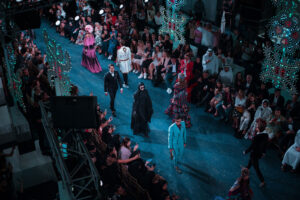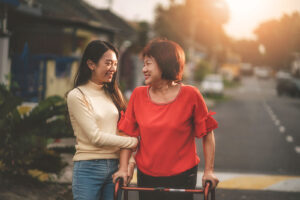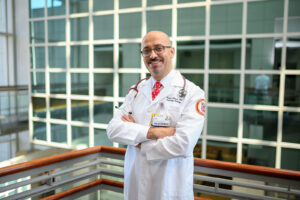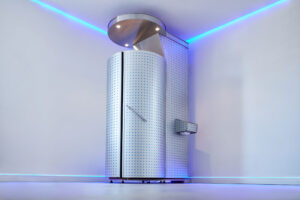As told to Catherine Eves
Whenever I tell my cancer story I always go from the year before. The year before I was diagnosed was 2016, and I was going in for routine surgery. They were just supposed to take a cyst off my uterus and do it laparoscopically, but it did not go as planned. I woke up with one less ovary, and that sent me into one of the darkest months of my life, honestly. Which sounds crazy, because I had cancer the year after, but [this surgery] really wrecked my mental health. My hormones were just up and down with the removal of my ovary. The doctors never told me that would affect my mental health, so I was so confused. I was like, why am I feeling this way? What’s going on with me?
I was sent into a depression with lots of anxiety. Coming out of that months later, I decided, OK, I need to get out of this house. I’m normally a very active person. I like to be with my kids outside, and I wasn’t leaving my house. So my husband and I went to a local fitness center, and I thought, maybe if I get into these classes I can stand at the back and do a little something and feel better. And that’s how I found fitness. It was through some of the darkest and scariest times of my life.
As I continued, I realized it wasn’t just physically that I started to change, but mentally and emotionally. I started seeing these little changes in my body, and I felt like the endorphins helped my mental health. I would leave the gym happier than I had been before. I got super addicted. I wanted to learn all I could about fitness, and within a couple of months […] I was the fittest I had been in my life. I felt so strong at that point. I felt like I knew my body better than ever.
Then the managers at the gym asked if I would become a fitness instructor. I was so nervous my first class; I didn’t have a lot of confidence. I knew I loved it, but I didn’t know if other people would, but [then] I realized my passion for fitness really did transfer over to others, and it encouraged others in the class.
[About] two months after I became a fitness instructor, that’s when I found the bump.
That’s why I start my cancer story from the year before, because I don’t think I would have noticed the bump if I hadn’t gone through [that surgery], because I was so in tune with my body. I knew it better than I’d ever known it. I found this tiny, little bump under my right arm. It felt like a mosquito bite. It was just so tiny, so I wasn’t worried at all. I felt strong, I wasn’t sick, it didn’t hurt, it wasn’t growing, so when I found it, I thought I just hadn’t felt this before, it feels like a lymph node. I thought maybe I was working out too hard.
I’m very passionate about doing self-checks in a certain way: I rotate my arm back and forth, because it feels differently backward and forward. [About one month after first feeling the bump], I did my self-check, and I couldn’t feel it. I thought everything was fine. A couple weeks later, I was in the exact same position, and I felt it again. It was more to the side of my breast by my armpit, so I never thought breast cancer.
It was so unassuming and so tiny; my mom and husband could barely feel it.
When I went to our family doctor for my daughter’s preschool appointment, I asked the doctor, “Hey, can you look at this tiny bump under my armpit?” I always say I hijacked my daughter’s appointment. The doctor looked at it, and she said, “If I did a breast exam on you, I never would have noticed this, it’s so unassuming.” And I thought, OK, great. Then she said, “But since you found it, if you want, I can send you for an ultrasound.” And because of what happened during my surgery the year before, I [wanted to] take every precaution.
[My] doctor’s office called [and] said, “Everything looks great; you can’t be 100 percent sure, but there’s nothing worrisome.” It was the one thing she said, that you can’t be 100 percent sure, and that changed everything. I told her I don’t want to have to do anything else in six months, so what can I do now?
She said we could do a biopsy. I didn’t know what a biopsy was; I didn’t know it involved needles. If I did, maybe I wouldn’t have done it. My husband and I were driving to the doctor’s office, and I kept thinking to myself, you’re being ridiculous, this is so dramatic — this bump no one could even feel, and everyone has said is fine — why are you getting a needle stuck into your body? I’m a woman of faith, and I truly felt like God kept putting this on my heart and wouldn’t let it go.
[My doctor] did an ultrasound-guided biopsy and I asked him, “I know you probably can’t tell me now, but what do you think it is?” He said, “I think it’s a cyst; I think it’s nothing to be afraid of.”
[But then] on Sept. 28, 2017, at 8 o’clock in the morning, that same doctor himself called me and told me it was cancer.
He was as shocked as I was. I got to the hospital, and it went bad fast. A one-and-a-half-hour appointment turned into six hours doing four or five different tests. It was one of the scariest days. That one tiny bump ended up being just the tip of my cancer iceberg. I had malignant calcifications across my chest wall. It had already spread to my lymph node underneath my armpit, so I was already at stage III when we found it. This was the most shocking, because I found it when no one else saw it, because I continued to keep pursuing it.
I ended up with six months of chemo, the “Red Devil,” the AC double chemo, as well as Taxol. After that I did my double mastectomy. I wanted to do reconstruction, so I had expanders put in. I also had 36 rounds of radiation. For me, radiation was harder than the chemo, because it’s so unknown. In Hollywood and the movies, you see enough images of bald women going through chemo. You see the sickness, the tiredness, all of that, so even the general public knows at least a little about it. But radiation, who films radiation? Who films the third-degree burns?
As a woman of color, my skin didn’t turn red, it turned black, and my skin reacted differently than white skin. And my doctors were honestly ignorant to that fact, unfortunately. They couldn’t help me the way they should have, because they weren’t prepared and didn’t want to acknowledge that black skin is different than white skin. I would search images on Google for radiation and come up with hundreds of pictures, but only two — maybe two — were of a brown-skinned person, so it was very isolating and scary.
All through my chemo, my radiation, I still taught my fitness classes. I came into the gym as much as possible. After my surgeries, I would sit in the back of the gym and sometimes just tap my feet. Sometimes I would just sit there knowing I was surrounded by positive people. It was like my sanctuary. I always say the gym is my church, my sanctuary; it’s where I have praised, where I have screamed, where I’ve cursed, cried, sweated. The endorphins would connect me with feelings that I didn’t even realize I had.
I have so many videos of me working out bald, working out barely moving after surgery. A couple months later, I’m moving a little more, then all of a sudden, I’m jumping around, then all of a sudden, I’m back down again. I think that’s the hardest part of cancer in general — those waves. They come so fast, and I don’t think anyone realizes until you’re in it. One minute I was strong and the next I’m looking at myself with a moon-shaped steroid face, and I had gained weight. So you have this sudden body dysmorphia; this sudden shock to your brain of your body changing so quickly. I was thinking, how do I get back to that place where I’m proud of this new body? Then after the radiation, my body just crashed.
I told my doctor, “I don’t think the cancer’s going to kill me, I think it’s the treatments.” I’m just tired, I was just so tired, so I opted to do a more naturopathic way of suppressing hormones. I went into an intense detox naturopathically, which was so hard but so necessary. I came out of that feeling like [I could] finally move my body again and step forward into reclaiming some parts of me. After that, I did my second-stage reconstruction, got my implants, and I was so happy. But four months later, I had a uterine ablation, because I had been bleeding excessively since chemo, and while I was recovering from that, I saw there was a recall of implants, including mine. They were recalled for causing another type of cancer.
I ended up having to explant at the beginning of 2020, and that was the toughest surgery yet. I was terrified, because I had three weeks to wrap my mind around looking down and seeing a deflated chest —not a flat closure or a small reconstruction or a botched reconstruction — but a deflated chest. I was finally falling back in love with this body, and now I would have to do it again; in a new way, in a scary way.
It was about three weeks after my surgery before I could look at my chest. I did it in my own bathroom, privately, because I couldn’t even show my husband. I knew I had to love that part of me before I [could] allow anyone else to love that part of me.
I ended up walking in New York Fashion Week for AnaOno three weeks after my explant surgery, which was insane. I had never even worn a two-piece swimsuit in my life, and here I was walking down the runway with other breast cancer veterans, in just a bra and underwear with no breasts. It was life changing, honestly, for me. After that I was also asked to introduce the mastectomy swimwear line for Target. It was so weird, because it felt like it was opportunity after opportunity saying, girl, you’ve got to start loving this body, because if other people love it, shouldn’t you also?
A huge part of that was my daughter. I would look at her and think, how can I say out loud around her that I don’t love my flat chest, when she’s standing there with a flat chest? Does that make her less of a girl, does that make her less beautiful to me? Of course not, I would never say that. And yet I would look at myself and feel those things. While I agree that we have to feel the loss and grieve, I think there is a point, too, of finding the beauty intentionally, finding the beauty in those broken and hard-to-love spaces.
I started doing what I call “mirror moments,” where I stand in front of my mirror — sometimes I’m completely naked and sometimes I have clothes on — but I look at my scars. I have 27 scars on my body from my neck to my hips, back and front, from 12 surgeries. I touch each scar; I just feel them and look at them and love them. I send so much love to those parts of my body. That is something I try to do daily, even if I can’t stand in front of the mirror for long, it’s to just look at myself and say, “Thank you, body. No matter what, you’ve shown up. No matter what has happened, you’re still here; you’re still kicking it.”
Each scar holds painful memories, but they also hold the memories of the times that I was resilient, and I survived. So that has held such power to stand there, and there are times when I’ve had my son and daughter with me in those moments, and I’ve lifted my shirt and been able to tell them the stories of these scars. [I] want them to realize whenever they get scars, they’re beautiful no matter what. That’s what body love is really about. It’s a daily decision; to say, “I’m going to show up, and I’m going to love this ever-changing body.”
This year is my first year in six that I don’t have a surgery. It has been a very revolutionary year, putting it mildly, of trying to figure out how to not just survive, but thrive. This year has really been about trying new things and facing fears and slowing down when I need to.
While I agree that we have to feel the loss and grieve, I think there is a point, too, of finding the beauty intentionally, finding the beauty in those broken and hard-to-love spaces.
Learning when to rest is hard for those of us who are cancer veterans. There’s a reason I say veteran over survivor: When you’re a car crash survivor, a fire survivor, you typically don’t have to go back into those traumatic spaces, but us cancer veterans do. We have to keep going back and doing scans and touching our bodies in the same places that they found cancer. That brings up mental health and PTSD — things that aren’t as accessible as I feel like they should be. So we have to figure it out, just like so many war veterans have to. We have to honor people who experience cancer and say, “I know you’re back, but [I know] there are things that are still hard.” And I think that’s the mentality we should have for cancer veterans. I know that just because your hair grew back doesn’t mean you’re done with treatment, that you’re done with the aftereffects of cancer. So today, I’m trying to figure out ways that I can thrive and not just survive. Honestly, it’s been terrifying, but it’s also been the best.
I have run faster than I’ve ever run in my life. I have broken personal records at the gym. I feel stronger. It’s so wild to look at my body some days and see those scars and those stretch marks and those wounds. I embrace the power of “and” — I see those things and I also see that I have biceps and I have this muscle. To me, that’s exciting, because that shows that there’s hope. There’s always going to be hope. No matter if you’re in the beginning of treatment, or you’re in this veteran status, there is hope that we can continue to do small steps to love our bodies, to be intentional each day, to look in the mirror and thank our bodies. Because no matter what we think, it’s still here, and it’s still showing up.







